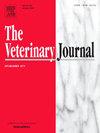三种不同装置对麻醉马匹的血红蛋白浓度测量结果一致
IF 3.1
2区 农林科学
Q1 VETERINARY SCIENCES
引用次数: 0
摘要
准确测量血红蛋白浓度对于监测麻醉马匹的携氧能力至关重要。本前瞻性研究旨在利用SpHb脉搏共血氧仪、Epoc®血气分析仪和填充细胞体积(PCV)得出的值确定麻醉马血红蛋白浓度的一致性,PCV作为本研究的参考方法。这项研究包括34匹接受选择性手术的马。从每匹马身上采集血液样本,用微红细胞压积法估计血红蛋白浓度([Hb]PCV_est)和Epoc®进行分析。使用Lin的一致性相关系数(CCC)和Bland-Altman分析将血红蛋白浓度与SpHb读数进行比较,预定义的可接受的临床一致性限制设置为与参考文献相差7 %。均值(Hb) PCV_est 14.6 ±1.8 g / dL的Epoc®(Hb)是11.0 ±1.8 g / dL和SpHb®(Hb)是9.6 ±1.5 g / dL。分析显示,与[Hb]PCV_est相比,SpHb和Epoc®设备之间的一致性较差。SpHb和Epoc®方法平均分别低估了血红蛋白浓度4.96 g/dL和3.6 g/dL。Lin的CCC显示弱一致性(SpHb为0.08,Epoc®为0.14)。Bland-Altman分析显示了显著的偏差,超过了可接受的7 %阈值,具有广泛的一致性限制。总之,SpHb脉搏共氧仪和Epoc®与[Hb]PCV_est方法的一致性很差,低估了麻醉马的血红蛋白水平。进一步的研究需要更大的样本量和特定物种的设备校准,以建立SpHb Radical-7®设备在马身上的真正准确性和临床实用性。本文章由计算机程序翻译,如有差异,请以英文原文为准。
Haemoglobin concentration measurement agreement obtained from three different devices in anaesthetised horses
Accurate measurement of haemoglobin concentration is crucial for monitoring the oxygen-carrying capacity in anaesthetised horses. This prospective study aimed to determine the agreement in haemoglobin concentration in anaesthetised horses using the SpHb pulse co-oximeter, an Epoc® blood gas analyser, and values derived from packed cell volume (PCV), which served as the reference method in this study. The study included 34 horses undergoing elective surgeries. Blood samples were collected from each horse and divided for analysis using the microhaematocrit method to estimate haemoglobin concentration ([Hb]PCV_est) and the Epoc®. Haemoglobin concentrations were compared to SpHb readings using Lin’s concordance correlation coefficient (CCC) and Bland-Altman analysis, with a predefined acceptable clinical limit of agreement set at a 7 % variance from the reference. The mean [Hb]PCV_est was 14.6 ± 1.8 g/dL, the Epoc® [Hb] was 11.0 ± 1.8 g/dL, and the SpHb® [Hb] was 9.6 ± 1.5 g/dL. Analysis revealed poor agreement between the SpHb and Epoc® devices compared to [Hb]PCV_est. Both SpHb and Epoc® methods underestimated haemoglobin concentrations by an average of 4.96 g/dL and 3.6 g/dL, respectively. Lin’s CCC indicated weak concordance (0.08 for SpHb and 0.14 for Epoc®). Bland-Altman analysis demonstrated significant biases, exceeding the acceptable 7 % threshold, with wide limits of agreement. In conclusion, both the SpHb pulse co-oximeter and the Epoc® showed poor agreement with the [Hb]PCV_est method, underestimating haemoglobin levels in anaesthetised horses. Further research with larger sample sizes and species-specific device calibration is necessary to establish the true accuracy and clinical utility of the SpHb Radical-7® device in horses.
求助全文
通过发布文献求助,成功后即可免费获取论文全文。
去求助
来源期刊

Veterinary journal
农林科学-兽医学
CiteScore
4.10
自引率
4.50%
发文量
79
审稿时长
40 days
期刊介绍:
The Veterinary Journal (established 1875) publishes worldwide contributions on all aspects of veterinary science and its related subjects. It provides regular book reviews and a short communications section. The journal regularly commissions topical reviews and commentaries on features of major importance. Research areas include infectious diseases, applied biochemistry, parasitology, endocrinology, microbiology, immunology, pathology, pharmacology, physiology, molecular biology, immunogenetics, surgery, ophthalmology, dermatology and oncology.
 求助内容:
求助内容: 应助结果提醒方式:
应助结果提醒方式:


